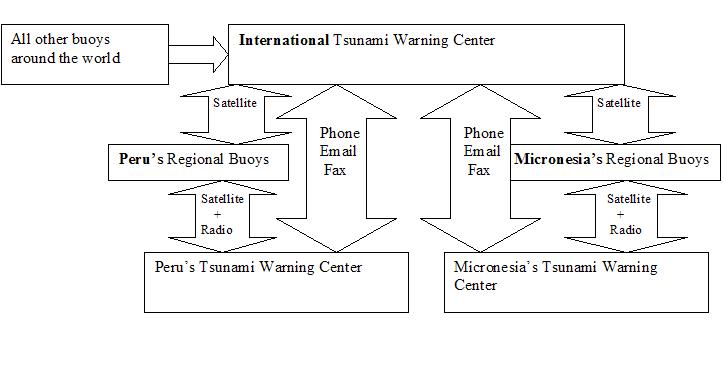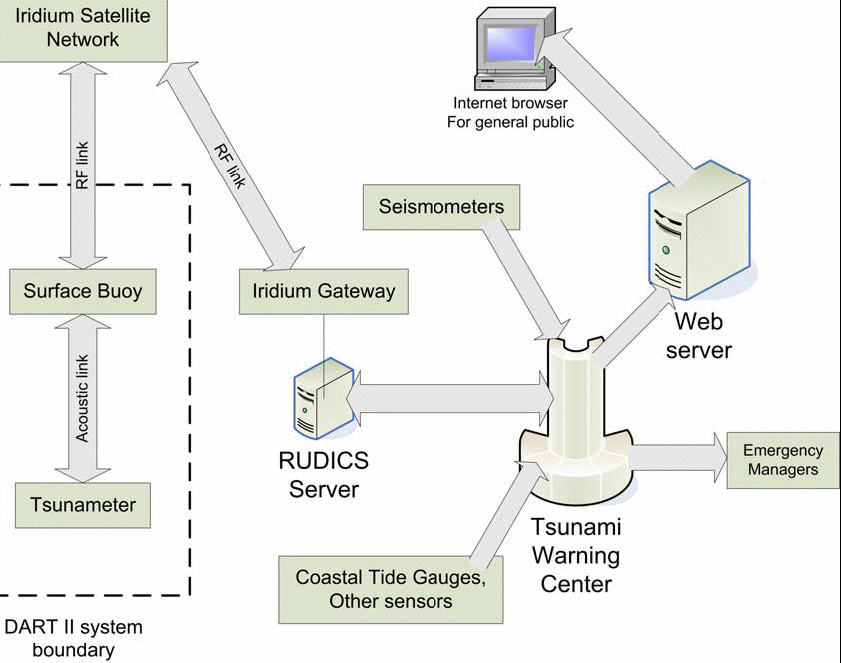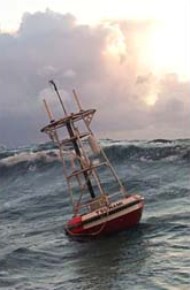Communications
Network
Summary of
Communications Network
The
tsunami detection communication network we propose to use for the
countries of Micronesia and Peru is based on the network used by
Pacific
Marine Expermemental Laboratory (PMEL). PMEL uses DART II buoy
sensors to
determine if a tsunami is approaching, these buoys are placed in ocean
depths
of about 4,000 feet. On standard mode, every 6 hours, the buoy
sensors report
average water height fluctuations for sampling intervals of 15 seconds
to the
warning center; t
he measurement
sensitivity of the sensor is less than 1 millimeter in 6000 meters.
Tidal reports have a sampling interval of 15 minutes. Tsunamis
that are generated by earthquakes,
cause the
Tsunami Detection Algorithm to turn the DART II system on to event
mode. Once the DART II
is
turned to the this mode, the system immediately attempts to send the 15
second
report to the tsunami warning center. The maximum delay time for this
message
is 3
minutes. The current communication network will have the buoy
communicating to
the warning center within 3 minutes. [Real-Time Deep-Ocean Tsunami
Measuring,
Monitoring, and Reporting System: The NOAA DART II Description and
Disclosure
Christian Meinig, Scott E. Stalin, Alex I. Nakamura NOAA, Pacific Marine
Environmental Laboratory (PMEL) Hugh B. Milburn].
Picture
credit: Christian Meinig, Scott E. Stalin, Alex I. Nakamura (PMEL)
Current Communication Network in
More
Detail
The current
buoy
communication network used by PMEL is outlined in the
above diagram. On standard mode, the surface
buoy reports data of the water height fluctuations every 6 hours
to the Iridium Satllite Network.13 The data it reports
includes the average water column height in millimeters corresponding
to 15 minute intervals, battery voltages, status
indicator, and time stamp.13
"Earthquake waves travel
significicantly faster than tsunami waves, and frequently trip the
tsunameter into 'Event Mode' before the tsunami arrives. The vertical
shifting of the seafloor from the earthquake acts to lift or compress
the water column above, showing an increase in pressure as the
seafloor rises, or decrease in pressure as the seafloor falls."
On event mode, a tsunami or earthquake is detected because a "detection
threshold" in the "Tsunami Detection Algorithm" was exceeded. At
this moment, waveform data is reported instantly with less than a
three-minute delay. 13 The first message it
sends in Event Mode is known as message #0. This message contains the
message ID, average water column height that caused the Event mode with
three height deviations, the exact time that it was detected, and other
data that ensures the validity of this data. Also, when the
system has reached event mode, the warning center can communicate to
the buoy and get more detailed data. After it has transmitted
the initial data,
data is continouisly reported every hour unitl the "Tsunami Detection
Algorithm" is in a "non-triggered" status. 13
Table
1: DART II performance characteristics
Characteristic Specification
Reliability and data return ratio:
Greater than 80%
Maximum deployment depth: 6000 meters
Minimum deployment duration: Greater
than 1 year
Operating Conditions Beaufort 9
(survive Beaufort 11)
Maintenance interval, buoy Greater
than 2 years
Maintenance interval, tsunameter
Greater than 4 years
Sampling interval, internal record:
15 seconds
Sampling interval, event reports: 15
and 60 seconds
Sampling interval, tidal reports: 15
minutes
Measurement sensitivity: Less than 1
millimeter in 6000 meters; 2 x 10-7
Tsunami data report trigger
Automatically by tsunami detection algorithm
On-demand, by warning center request
Reporting delay: Less than 3 minutes
Maximum
status report interval: Less
than 6 hour
Table 1 credit; Christian Meinig, Scott E.Stalin,
Alex I. Nakamura, Hugh B Milburn (PMEL)
Communication to
Tsunami Warning Centers
An
international Tsunami Warning Center exists in
Hawaii. Our plan is to send the warning and data from the buoys through
satellite communication to the international tsunami headquarters,
which will in turn send a warning to all other tsunami detection
headquarters. We also plan on having the buoys directly
send data through radio communication to regional
headquarters in both Peru and Micronesia.
Peru
already has a tsunami detection headquarters or tsunami warning center
in
place. That headquarter is run by Peru's navy. We propose
to send the buoy's data to this regional tsunami warning center under
the
condition that if a tsunami is detected the warning will be
communicated directly to the people and media without political or
further government interference. The sensors communicate the detection
of a tsunami within 3 minutes. It would defeat the sensor's
efficiency
if the warning is delayed by any interference or consultation with
government or other authority. Scientists, not government, will
determine if a tsunami will hit their country and in what time and with
what strength it will hit. The scientists
working at headquarters will
issue the warning that will go out to the people through the country's
tsunami warning system.
Unlike Peru, Micronesia does not yet have a
headquarters in place. Although at this moment we have not
determined
where the regional headquarters for Micronesia will be located, it will
likely be located on Micronesia's higher elevations. The regional
communication system for Micronesia will work very similar to that of
Peru. We have yet to determine if the headquarters will also be
run by the Navy of Micronesia, or by some international tsunami warning
group. Other than these concerns, Micronesia's regional headquarters
will have the same structure of communication as that of Peru. Both
will recieve data directly from their regional buoys to their
headquarters via radio communication, as well as warning from the
International headquarters in Hawaiii.
We propose this
communication structure because it
is nearly fail-safe. Let's look at two cases. In the case that regional
headquaters has a problem, international headquarters, which recieves
warnings from all the buoys in the world, will then alert the regional
headquarters. In the case that international headquarters has a
problem, regional headquarters will still recieve data from their
regional buoys and thus can issue a warning.

Picture Credit: Nasly Jimenez (MIT '09)
In
summary, we propose that Peru
and Micronesia adopt the DART II system, but we also
propose that a regional tsunami warning center is established in each
of
these
countries, as well as a buoy system. The buoy sensor will communicate
to the
regional tsunami warning center via radio and satellite while,
the buoy will
also report to the International Tsunami Warning Center via
Satellite. The
international tsunami warning center, which is located in Hawaii, will
receive
data from all of the buoys around the world. They will warn regional
tsunami
warning centers in the case of a tsunami. Thus, we propose a
nearly fail-safe
communications network, with direct communication from regional buoy to
both
regional and international warning centers via sattellite and in the
case of
regional-regional , via radio. Thus in the event that one of the warnign
centers or regional buoys are not working properly, the international
warnin
center can issue the warning for that country intime to save people's
lives.
Peru, already has a buoy sensor in place as
well as a tsunami warning center.
The problem with Peru's tsunami warning center, is that it is run and
managed
by its Navy. On the other hand, Micronesia has yet to have a regional
buoy, or
a tsunami warning center. Funding, building and management for its
warning
center is a problem that our class would have to address.
Proposed Tsunami Network Systems
as of 11/04/05
Our class has discussed the possible tsunami network
systems that will make warning and evacuation, in the case of a tsunami
most efficient.
One of the possible tsunami network systems that were discussed, Network System A is summarized in
the flow diagram below.
<Insert diagram>
Another possible network, Network
System B is explained in the following flow diagram.
<Insert diagram>
The advantages and disadvantages of the differences in these proposed
network systems still need to be analyzed.
1.
In the event of a tsunami, in other words, when the
DART II system triggers event mode, a
critical difference exists between the operation of the first
network system A and the second network system B.
Network system A, consists
of the buoy sending data to the warning centers to have scientists
analyze and verify that this data is reliable and that a tsunami will
definitely occur near a certain area. The advantage to this system is
that it will in the least significantly minimize, if not eliminate the
possibility of
a false alarm, which if occurs could diminish the effectiveness of the
entire warning system.
On the other hand, network system B, consists of the buoy
not only sending data to the warning centers immediately after a
tsunami is detected, but to simultaneously trigger a warning of the possibility of a tsunami. Once it
is triggered a warning of the possibility of a tsuami will be issued to
the community through the tsunami warning system, which includes but is
not limited to: sirens and radios. In order to prevent the attitude
towards a false alarm, the ring of the siren, the message on the radio
and other communication systems will only warn people that there is a possibility of a tsunami hitting
their area. Thus it will be a lower level of warning than if it is verified that a tsunami will
hit. Since the buoy's data still goes to the warning center, the
existence of a tsunami can be verified, and thus the level of the
warning is increased. The advantage to this system is that all
operations will have more time, (a minimum of 5 more minutes) to
prepare in the case that it is a real tsunami. The disadvantage to this
system is that if the lower level of warning is frequent, or too
frequent, the regard for the warning could be taken lightly by the
people and thus decrease the efficiency and purpose of the warning
system. We must still answer if it is possible to have this extra time
without creating this apathy towards the warning system.
Another problem with these network systems consists involves the
communication of a tsunami warning to the governments of Peru,
Micronesia and other nearby countries. If there was a law in place that
guaranteed the tsunami warning center to issue a warning directly to
the people in the case a tsunami was detected, with not much but
notifying government simultaneously, then the network system will be
much more time efficient. Of course, this idea still needs to be
modified in a way that would be acceptable to the governments of Peru
and Micronesia.
3.
All these network systems assume that if an earthquake caused a
tsunami, the magnitude and location of the earthquake would be sent
immediately to tsunami warning centers.
My Annotated Bibliography
1. Peru's
Tsunami warning Center Website
Sources
quoted directly
Graphic
for banner on this page from http://www.noaa.gov/tsunamis.html

Page
last updated by nasly at 11/04/2005 5:20:14 PM


